”Form is essential to art in that it mediates content. Form is the artifacts coherence, however self antagonistic and refracted, through which every successful work separates itself from the merely existing. …what can rightly be called form in artworks fulfills the desiderata of that on which subjective activity takes place just as much as it is the product of subjective activity” ( Theodor Adorno )
Sacheverell Sitwell called Wolfgang Amadeus Mozart ”the most gifted human being that has ever been born.” Who was the man behind his mask, this untypical romantic genius who defied categorization . Mozart’s mind was so unlike that of other mortals that no one could really understand him, least of all himself. Over time, mythology and illusion have served to create a new script, new sheet music for an opera on the life on Mozart that detours verities and appropriates artistic liberty to stretch and shape a narrative both expansive and constrictive on the composer. Legends it is said, are often like inverted pyramids, vast superstructures resting on vanishing points. Also, geniuses are seldom liked until they are dead, after which vultures flock over the carcass picking over the remains.
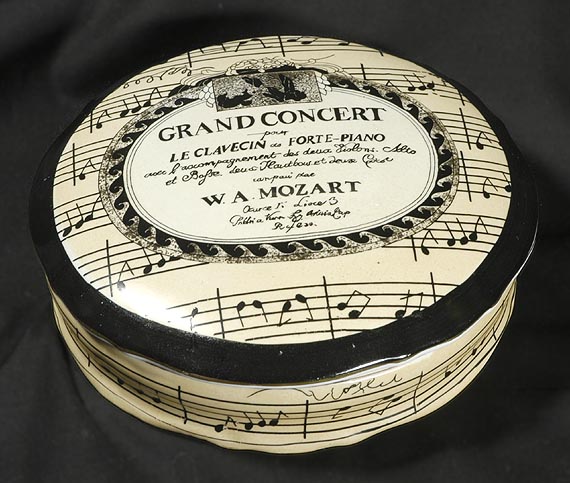
Mozart porcelain box. ''The elaborate title pages of eighteenth-century publications served to attract the bourgeois market as much as to honor the dedicatee. Stripped of the music behind it, the title page remains a nostalgic reminiscence of an era of class.''
”Mozart’s genius went hand in hand with a near total absorption in the subject of it, which rendered him unfit for everyday life… he would not compromise his primary mission for the sake of worldly considerations. His absorption in music made him a narrow man, with no interests in other aspects of cultural and intellectual life. It tended to cut him off, not only from others but also from materiality itself; his humor is in part an attempt to get back in touch with everyday things, and because the life of his musical mind was so abstract and elevated, the more concrete and earthy the humor the better.” This gives insight into the buffoonery and coarse humor which acted a mask, a barrier behind which the genius hides from others, who he may subconsciously feel, are unworthy to be admitted to his inner sanctum. The comic also served as a vehicle for relaxed and friendly relations without the burden of mutual self revelation which Mozart neither wanted, nor perhaps, could attain.
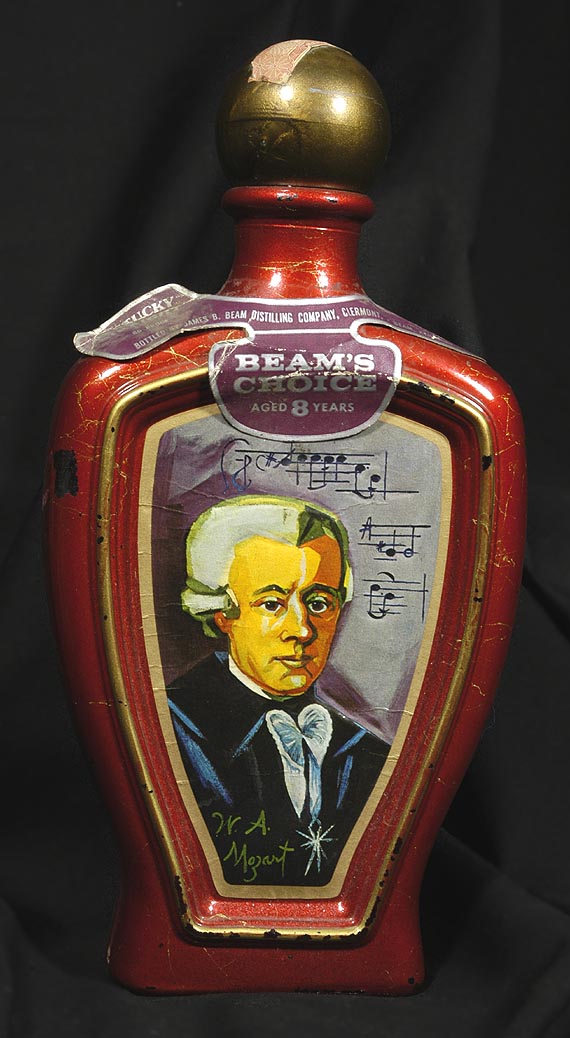
Kentucky ''Mozart'' straight bourbon whiskey.''Mozart stands for culture and thereby has come to represent the aspirations of a middle class for whom Kultur has been commodified. Since the industrialization of the nineteenth century, mass-produced cultural goods—packaged in the canon—have become a capitalist value. The cultural icon has become a market force to be reckoned with.''
Its a tale of two myths which fits appropriately into the duality of human nature and the dichotomy between classicism and romanticism, and the inner person and his exterior perception.The first myth stemmed from a belief that an opera composer could not convincingly depict emotions he had not experienced. A novel by Heribert Rau invents a passionate adolescent affair with Giuditta Uslinghi and then renews the tryst at the time of the composition of Don Giovanni in order to accentuate the testosterone in the narrative. Arthur Schuring has a Nietszchean admiration for this opera in which he plays the card of eternity of passion, and a life driven by elemental powers. Schiedermair argued that Mozart, by necessity, experienced the appetites of the Don in order to understand and depict the type. According to the second story, Mozart is destroyed by women, he was no Don Giovanni and not masterful and successful with women at all. He was susceptible and uxorious and it was his misfortune to be pulled into the orbit of the Weber family.
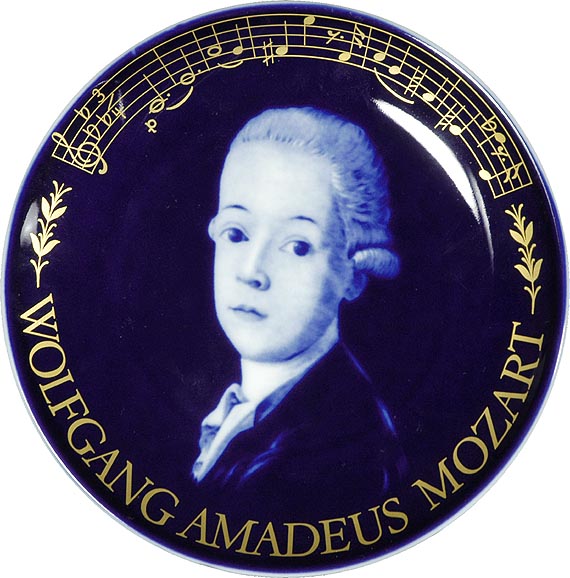
''The portrait on the plate is the famously misattributed depiction of Mozart’s childhood friend, Count Karl Firmian, as a young boy, who eternally travels the world as "Wolferl." In its function as drawing-room adornment, the portrait recedes into symbol; the innocent boyish face appeals to our nurturing instincts—the seeds of the genius we seek to possess, in their vulnerable childhood shell.''
In all likelihood, Mozart did not see himself in relation to the world at times. By necessity or self preservation,he often related to others through convention which he adopted and discarded like clothes in that they never expressed his true inner self. They were masks, except for his music. The gift of Mozart’s genius was both a blessing and a curse; it conferred insight and made possible artistic greatness far beyond mere craft and skill; but at the same time it set him at odds with the tame, reasonable, orderly everyday world. Similar to the Alice Miller concept, Mozart intuitively exposed the lie of insanity/irrationality being explained by logic and rationality. Taking Miller, a better term for Mozart would be that of ”overcomer”, ” …for these people show how light overcomes darkness and love overcomes hate. It is a characteristic of being effortlessly ( automatically ) expressed, and not subject to choice or volition…these beings are pure expressions of the Creator-God/dess…. They may do anything or nothing without being subject to moral judgement. Theirs is merely the task to be what they are wherever they are-anywhere, anytime.” ( Alice Miller, Heralds of a New Age )
Don Giovanni was written in 1787 and nothing else written at tat time, such as Goethe’s ”Iphigenie” , Edward Gibbon’s ”Decline and Fall” or even the United States Constitution still has remotely the same power to fascinate the mind while arousing passion at the same time.The mixture of chromatic arabesques and tonal deceptions which seem seamless due to the absence of sudden shocks, volte-face modualtions and clumsy plunging with which some of Mozart’s lesser contemporaries peppered their works. It was the musical equivalent of Einstein’s unified field theory in that there was a coexistence between form and life within the musical language. Later with Nietzsche, art would become entangled in the guilt context of the living.
Mozart was able to wander from key to key, creating a sense of the unusual, yet not offending the ear. ” In Mozart the unity of the work was occasionally playfully tested by its relaxation. By juxtaposing relatively disjointed or contrasting elements, Mozart, the composer who is praised above all others for the rigor of his form, masterfully juggles the concept of form itself. He is so sure of its strength that he effectively lets go the reins, on the basis of the security
the construction itself, giving the lead to centrifugal forces” ( Theodor Adorno )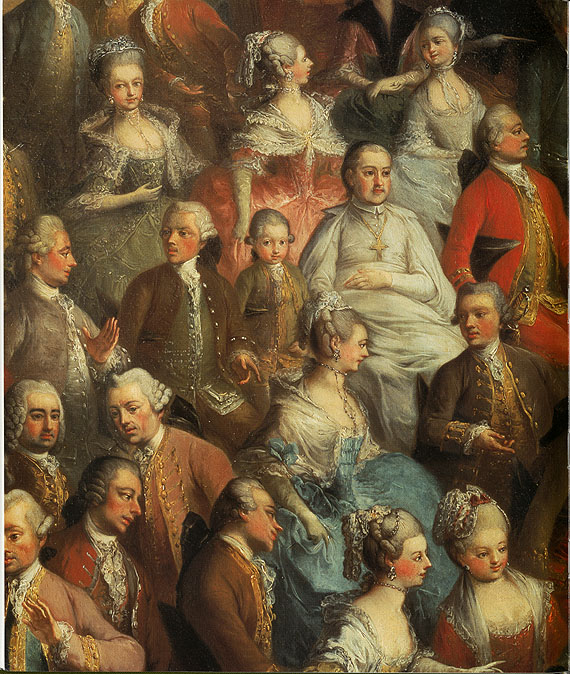
Unauthenticated Portrait. ''Martin van Meytens was Empress Maria Theresa’s court painter. This portrait (assuming that it is him) stands out among the depictions of the child Mozart. Rather than depicting Mozart as somehow removed from the real world, either as the cherub-child not quite part of this world or as the musical genius bordering on automaton, the artist portrays Mozart here as the most aware person in the crowd, gazing towards the viewer with disarming seriousness.''
During the final years of his life, Mozart was pursued by financial troubles which began much earlier. The Weber family, headed by the ”Bad fairy” Maria Cacilia, had offloaded the talentless third daughter Constanze onto him, perhaps initiating the catastrophe and the beginning of his martyrdom. Mozart was in love with Aloyse, the second daughter, but after he had trained her voice and she established herself, it became apparent that this family of Bohemian spendthrifts were using him. In fact, Mozart turned down an offer of organist at Versaille to fruitlessly pursue her. Regarding wife Constanze, there is doubt whether she actually loved him. Only after his death, when his scores began to fetch high prices did she realize she had been living with a genius.
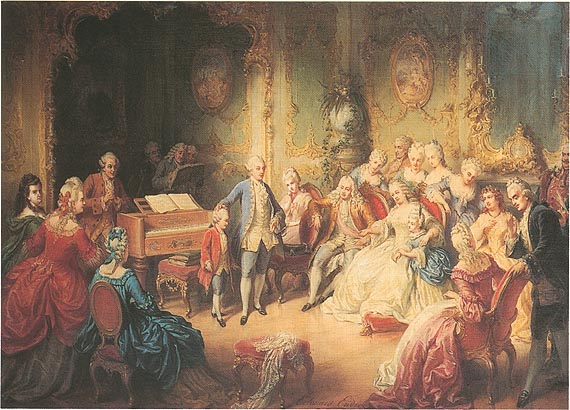
Young Mozart; imagined. Eduard Ender 1869.''Ever fascinated with the idea of Mozart the child prodigy, and ever trying to capture the charm and spectacle associated with the idea of the boy genius, artists have produced numerous depictions of Mozart being presented to Empress Maria Theresa.''
The last of his three symphonies, written in 1788 reveal nothing of his dire monetary problems.His distressing letters about debts and the risk of homelessness can be seen as tragic arias from an opera ”seria” transmuted into conventional prose. The passionate discontent in symphonies 39,40 and 41 belongs to another order of anguish. The troubles could not reach his music, but in the end they destroyed him physically. In the end he had been fulfilling the promise of his early genius when he fell ill. It was an unfinished Requiem Mass that had been commissioned by an ”unknown gentleman” whom Mozart instinctively recognized as the messenger of death.He died of rheumatic fever and an ensuing cardiac collapse. It is known that he remained conscious to the end and that he died ”calmly but most unwillingly”. On the day of his death he had the score of Requiem brought to his bed, ”didn’t I prophesy I was writing this Requiem for myself?” So he spoke and looked through the whole thing attentively once more with wet eyes. It was the last anguised look of parting from his beloved art”. ” ( Sitwell, Mozart, 1932 )
Certainly, Mozart went against the dictum of great art being based on injustice and suffering; death and guilt as a necessary condition and an excuse in not confronting the sensitive and intuitive. Mozart was the exception, and an irritant to those innumerable artists maintaining a hostility to the future and a glorification of unresolvable conflict except through a tragic finale. The creation of a myth of an isolated, disconnected and lonely individual might be plausible, but does not detract from the basic premise that Mozart would have reached such great heights despite his father, debts, Contanze and the academic efforts to heap doses on neuroticism upon him in an effort to make him more ”human”. Mozart’s art did not live on conflict and was not a product of ”the dark satanic mills” from which romantic genius is considered to gestate and spring forth.Leonard Cohen, with appalling hostility to the future, and a certain sentimental fondness for remaining comfortably numb within the colonial yoke of the Babylon captivity; wallowing in guilt and a structure of control is a good example, at least in this song, of the dominant ”masculine” art within a patriarchic world view:
Give me back my broken night
my mirrored room, my secret life
it’s lonely here,
there’s no one left to torture
Give me absolute control
over every living soul
And lie beside me, baby,
that’s an order!
Give me crack and anal sex
Take the only tree that’s left
stuff it up the hole
in your culture
Give me back the Berlin wall
give me Stalin and St Paul
I’ve seen the future, brother:
it is murder.
You don’t know me from the wind
you never will, you never did
I was the little jew
who wrote the Bible
I’ve seen the nations rise and fall
I’ve heard their stories, heard them all
but love’s the only engine of survival
Your servant here, he has been told
to say it clear, to say it cold:
It’s over, it ain’t going
any further
And now the wheels of heaven stop
you feel the devil’s RIDING crop
Get ready for the future:
it is murder. ( Leonard Cohen, The Future )


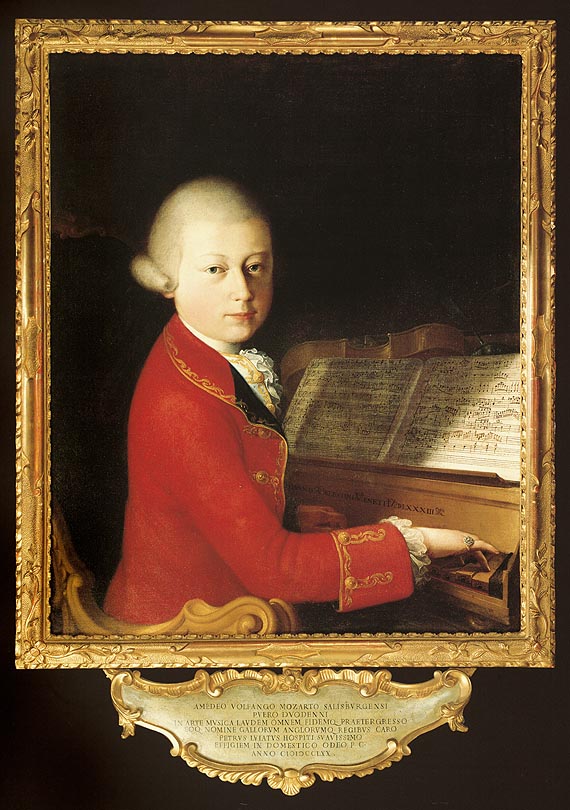



 COMMENTS
COMMENTS